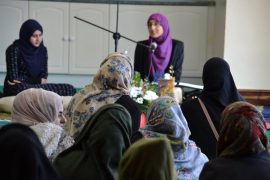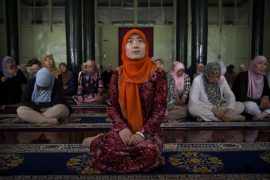The gendering of both public and private space must be viewed through a contextual and religiously sensitive lens. The notion of women’s presence, rights and leadership in mosques has long been debated in diverse milieus. Drawing upon the works of El Guindi, the spatial and temporal fluidity when addressing gendered roles, in this instance, is considered pivotal in understanding the leadership of women in the sacred space. The emergence, re-emergence and inflation of female leadership in the religious space of many diverse communities mirrors a shift in the misogynistic dominance of the Muslim world. This shift not only highlights the valuable skills female leadership offers, but recognises the pursuit of female space on a more general level.
Leadership does not come without the notion of authority. Authority in the Islamic context is much different to many other religions, as Islam does not have a traditional hierarchical structure or clergy. A precondition of authority is legitimacy, legitimacy in the sense that the authoritative figure receives recognition and consent to lead. Many authors have aimed to depict the concept of authority and legitimacy, with Weber’s framework outlining three non-sequential conditions to legitimacy: charisma, legal rational and tradition. The first embodies allure, the second is that of standardized regulations and practises, and the latter refers to established and conventional conceptions and structures. Gaffney goes further in identifying three different positions of authority in the Egyptian context: the saint, scholar and warrior. It is important to not only appreciate the non-homogenous diverse degrees of authority, but to apply them to different types of leadership roles, based either on stimulus, structure or merit. The arguably decentralized and multi-faceted nature of Islam in this postmodern context harbours both difficulty and opportunity with regards to female leadership.
Muslim women’s struggles in attaining leadership must not only be acknowledged and accepted as reality but the pursuit for it should be encouraged and developed, as Muslim women offer an insight into both the private and public realm that their male counterpart fails to offer. The encouragement of female leadership within Muslim communities should be met through social, educational and financial support. This article aims to address the need of female leadership in Islam, both historically and in this contemporary post-modern age.
The notion of female leadership in Islam has experienced little scholarly analysis in both social and political domains. This lack of appreciation does not equate to a lack of influence of female Muslim leaders in their respective institutions and community structures. Rather, the shift from a patriarchal domain to a substantially more meritocratic arena must be recognised as intrinsically associated to larger socio-political changes impacting Muslim communities on both a local and global scale.
Historically, the empowerment of women in Islamic society has been weakened through time, with a decline in the status of women after the time of the Prophet. Evidence of this social and religious deterioration can be found in Leila Ahmed’s survey of Women and Gender in Islam. Some scholars have gone as far as stating the ignorance of women in Islam due to their exclusion from the religious space. The impact this type of exclusion can harbour is manifold. Through both a historic and contemporary lens, the role of women in society is understood as paramount, although historically this role is likely to be confined to the private sphere whereas currently the role of women in society is developing in both the public and private domains. This development in both the religious and social spheres recognizes not simply the importance of female empowerment but the influence women have in society.
To fully appreciate female leadership in Islam, the wide spectrum of female leadership must be acknowledged; from those recognised and contributing to the works of some of the oldest, most respected, Islamic institutions, to those actively challenging traditional gender norms in both the context of their community and religion. This wide spectrum of both theory and practise can unite those previously divided by linguistic, regional or disciplinary barriers. Kalmbach (2011) reiterates the importance of recognising the true scope and merit of female leadership in Islam through both textually and contextually sensitive understanding.
Today, women are not only the mothers, sisters and wives of educated, reputable and religiously defined men, they are in fact the embodiment of resilience. Through such resilience women are, and will continue to be, beacons of empowerment in all contexts. The traditional role of women, when perceived as a mother and wife, does not come without aspects of leadership. This leadership may take form in running the household or raising children, yet when equating these duties to leadership is too often overlooked. Somewhat of a subordinate position has been imposed with regards to female leadership in all arenas. Yet this backseat is now challenged, with women exhibiting their abilities as leaders of Islamic scholarship and understanding in some of the most reputable institutions globally.
We must now begin to question, if prominent institutions in the Islamic domain are accepting and encouraging female leadership, why does the local mosque fail to follow suit? We must accept, encourage and support female leadership in Islam, not simply as an avenue for female empowerment, but to empower the entirety of society.




